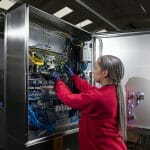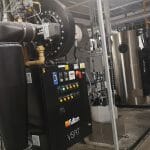Bridging the gap between information technology (IT) and operational technology (OT) is an essential step in realising a truly smart factory. When IT and OT converge, data collected from IoT devices can be efficiently analysed and quickly turned into valuable information. Edge computing sits right in the space between IT and OT and can therefore facilitate the converge of these seemingly distant worlds. In this article, Neil Ballinger, head of EMEA sales at automation equipment supplier EU Automation, explains how.
IT and OT have traditionally existed as separate entities, serving distinct purposes. IT consists of computer systems that create, transmit and safely store data, while OT encompasses the hardware and software running and monitoring production systems on the factory floor level.
Recently, the advent of the Industrial Internet of Things (IIoT) has brought these worlds together. IIoT devices on the shop floor generally have integrated communications capabilities that allow them to collect and transmit data that manufacturers use to maximise productivity and minimise downtime. This data has to be processed, stored, and protected from cyber-attacks, all tasks that require the expertise of IT management teams.
To fully reap the advantages of Industry 4.0, forward-looking companies are converging IT and OT. Examples of converged IT/OT systems are now common in manufacturing and include machine vision applications, tracking systems, remote condition monitoring systems and many more.
The challenges of big data
IT/OT convergence enables manufacturers to efficiently process huge amounts of unstructured data. One way of managing data is to send it to the cloud, where it can be processed, filtered and turned into information that manufacturers can act upon. However, processing big data directly in the cloud requires long response times and a large amount of bandwidth. Edge computing provides a viable solution to this problem.
In edge computing, data is processed as closely as possible to the source where it is generated, without involving the cloud. In this way, huge amounts of unstructured data can be analysed and filtered directly on the shop floor, and only the relevant data will be sent to the cloud for long-term storage or for distribution across multiple networks.
Processing data at the edge has multiple advantages. Firstly, it offers substantial improvements in response time and bandwidth consumption. Secondly, it minimises data transfer and with it the possibility that data will be stolen or damaged by cybercriminals while it is uploaded to the cloud. Finally, by reducing the amount of data that must be processed and stored in the cloud, it lowers the cost of cloud management.
A pathway to IT/OT convergence
One of the issues that can hinder IT/OT convergence is the different frequency at which data is collected. OT operates in real time with process speeds of milliseconds or below, while IT requires much longer sampling times. By reducing computation times, edge computing brings these worlds together and offers plant managers the chance to perform sophisticated data analysis in real time.
There are several examples of edge computing solutions that help companies bridge the IT/OT divide. Mitsubishi’s MELIPC Edge-Computing, for instance, combines a ruggedised hardware with the possibility to log and analyse data in real time. This and other similar solutions bring IT onto the factory floor, supporting manufacturers in their journey to Industry 4.0.
IT/OT convergence is one of the many challenges that manufacturers have to overcome to fully reap the benefits of digitalisation, but a smart combination of edge and cloud computing for data analysis can make a huge difference in making the smart factory become a reality.
For more information on how to successfully integrate edge computing solutions into your smart facility, visit www.euautomation.com/automated.








